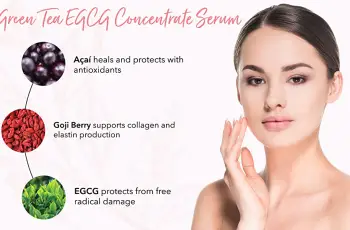
Can peptides be used with niacinamide?
The beauty industry is constantly evolving, which means there’s always something new to try! These can be trending ingredients that have just hit the market and are improving everyone’s complexion, or others that have been around for a while and are just getting the acclaim they deserve!
When it comes to the ingredients peptides and niacinamide, all of which have impressive skin benefits, it’s no wonder the question of “can peptides be used with niacinamide?” comes up time and time again. If you’re unsure what peptides are and how they benefit the skin, check out our blog post.
Can’t niacinamide and peptides be mixed together?
Yes, you can! Niacinamide and peptides are considered completely safe to use together. Since niacinamide is suitable for nearly all skin types, even mildly sensitive skin, it can work effectively alongside other skincare ingredients. Niacinamide’s moisturizing properties allow it to draw moisture around the skin and bind it to its natural protective barrier. The skin’s microbiome can remain fully functional and at its healthiest, allowing it to protect itself from free radicals such as UV rays, pollution, and other environmental influences.
If you want a better understanding of what not to mix with niacinamide, you can check out our blog for more information.
Can I use Niacinamide with Copper Peptides?
Yes, you can. Copper peptides provide the skin with impressive antioxidant benefits, ensuring it is protected from free radical damage while repairing any damage that has already occurred. They stimulate the production of elastin and collagen in the skin, helping to smooth the complexion and visibly reduce fine lines and wrinkles. An added benefit of copper peptides is that wounds heal faster, and combining it with Niacinamide yields impressive results. Niacinamide is widely regarded as a powerful moisturizing ingredient that can be combined with many other effective skin care ingredients (except Vitamin C).
Copper peptides are known to increase blood flow, which is why they are so effective in healing wounds and other skin injuries. A common side effect is that they increase facial redness or possible flushing, which can cause severe irritation if you are already using exfoliating ingredients.
I have discussed in previous blog posts the importance of doing a 24-hour patch test before applying a new ingredient or formula to your face.
Which came first, peptides or Niacinamide?
The general rule of thumb when using skin care is to start with the thinnest consistency and use the thickest consistency last. This helps us all have a clearer understanding of how to apply skin care. Another factor many of us don’t take into account is that our skin has a 24-hour circadian rhythm. This basically means that our skin’s needs change depending on the time of day.
For example, in the morning it needs protection from free radicals from UV rays, pollution, and environmental aggressors. When night falls, the skin focuses on repairing and regenerating itself. Many people opt for higher potency formulas because they have limited exposure to free radicals and the skin has limited time to regenerate while sleeping.
Are peptides better than niacinamide?
Yes and no, as each ingredient has different benefits for the skin. Peptides and niacinamide each target different skin concerns and can improve complexion overall when used alone or layered together.
Here are some examples of issues these ingredients can help with:
Choose Niacinamide if you have:
Hyperpigmentation, dark spots, sun damage, and post-acne scars
Mild acne and breakouts
Redness and blotchiness, such as rosacea
The first signs of aging, such as fine lines, wrinkles, and crow’s feet
Choose Peptides if you have:
Skin loses firmness and signs of sagging
Deep, visible wrinkles on the surface of the skin
Luckily, we can combine all of these powerful ingredients and use them twice a day, morning and night.
Which is better, ceramides or peptides?
There is no right or wrong answer to this question, as both offer unique and effective benefits to the skin. Whether you use them together or separately, you’ll be surprised at how your skin looks and feels.
Skincare Benefits of Ceramides
Skin’s surface is hydrated and moisturized
Skin barrier remains fully functional
The overall appearance of the skin is improved
Skin becomes firmer
Skin protects itself from free radicals
By providing extra hydration and preventing further damage to the skin, ceramides not only produce dramatic results, but also improve skin health. They also teach the skin to produce its own ceramides. The result is a smoother, healthier, more youthful complexion.
Skincare Benefits of Peptides
Improve skin tone
Reduce signs of aging like fine lines and wrinkles
Restore proteins in the lower layers of the skin
Provide cell communication benefits and boost collagen production
Help maintain a smooth, healthy skin surface
As mentioned earlier, there are a variety of peptides available in skincare formulas, each with its own unique benefits. The good thing is, you can actually use both ceramides and peptides together to dramatically improve your skin.
Do peptides really work?
The short answer is: yes, but only if used correctly. Since peptides are so small in molecular size, they can penetrate to a much deeper level. While peptides benefit the skin in the many ways I’ve already mentioned, they tend to break down quickly. That’s why it’s important to find the best products to ensure you reap the benefits of using peptides in your skincare routine. For example, if you opt for a lightweight serum, the peptides won’t have to compete with the barrier of a thick cream that sits on the outer surface of the skin. If you’re really serious about your skincare routine, you can combine active peptide levels with other powerful skincare ingredients like niacinamide to improve your skin’s appearance across the board.
So you can learn more about using peptides with niacinamide here As always, don’t forget to follow Procoal on Instagram if you have any questions.


